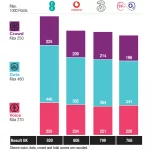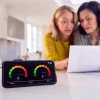Survey Claims 54% of UK Mobile Users Suffer Signal Woes at Home

A new Opinium based survey from Uswitch.com, which questioned a “nationally representative” sample of 2,000 UK adults during February 2021, has found that 54.4% of respondents (equivalent to 29.5 million UK consumers) have suffered from some form of mobile signal “issue” at home, and it’s worse in rural areas.
The survey claims that 27% of respondents have had to move to another room because of poor mobile reception, while 19% opted to use a messaging service instead (WhatsApp or iMessage etc.) and 14% simply left the house in a bid to get a better signal.
When mobile users asked their network operator for help with reception issues, some 37% were told to try making calls over their Wi-Fi instead (i.e. many Smartphones can send and received calls by routing traffic over a good WiFi connection, such as via your home broadband router). But, although 39% of mobile users regularly use Wi-Fi Calling, more than a third of consumers (35%) still don’t know what it is.
Advertisement
Summary of Survey Highlights
— Reception issues are at their worst in semi-detached houses, with 30% of residents enduring a substandard signal. Thick walls and some types of insulation can interfere with how well the signal reaches phones. In fact, people who have extended their property are more than twice as likely (63%) to suffer constant problems with their mobile reception as those who have not (31%). Meanwhile 41% of those with loft extensions also complained that calls dropped out regularly.
— Rural areas suffer the biggest issues with mobile reception, and are almost 50% more likely than residents in suburban regions to face failed calls. Some 40% of residents living in the countryside complain of dropped calls, which falls to 33% for urban areas and 27% for suburban regions.
— Mobile users most commonly experience problems in the living room (39%), while the bedroom (31%) and kitchen (29%) were next worst, and 10% complained of poor reception in the toilet.
— 51% of mobile users didn’t check the coverage in their area before choosing a provider.
Residents in London, Edinburgh and Belfast are most likely to endure failed calls due to signal issues (18%). Meanwhile, EE topped the table for providers whose customers complain most often about calls dropping out, which is interesting considering that they do so well in various other surveys (e.g. Rootmetrics). Equally, we’re unsure how EE can be the worst, while BTMobile (MVNO for EE) is the best. A bigger sample size was probably needed.
Table: Cities most affected by calls dropping out entirely
| City | Percentage of people affected by calls dropping out often or all the time |
| London | 18% |
| Belfast | 18% |
| Edinburgh | 18% |
| Newcastle | 17% |
| Bristol | 16% |
| Birmingham | 14% |
| Brighton | 13% |
| Norwich | 13% |
| Plymouth | 11% |
| Nottingham | 11% |
Table: Providers whose customers complain most often about calls dropping out
| Provider | Percentage who had signal problems at home |
| EE | 18% |
| O2 | 15% |
| Vodafone | 14% |
| Virgin Mobile | 11% |
| Tesco Mobile | 8% |
| Three UK | 8% |
| GiffGaff | 6% |
| BTMobile | 6% |
Admittedly 4G and 5G mobile (mobile broadband and calls etc.) connectivity remains an inherently highly variable technology. Users of such services are always moving through different areas, using different devices with different capabilities and the surrounding environment (weather, trees, walls, buildings etc.) is ever changeable.
Advertisement
All of those issues can impact your signal, and that’s before we even consider network (backhaul) capacity or spectrum ownership. People living in urban areas are often surrounded by a much denser mobile network with more spectrum availability, which tends to aid indoor coverage, while rural deployments need to keep costs down in order to ensure maximum coverage and that means using lower frequency bands (these are actually quite good for indoor coverage, but the signals do still get pretty weak over distance).
The new £1bn Shared Rural Network (SRN) industry project, which aims to help extend geographic 4G coverage to 95% of the UK by 2026 (it may also help the 5G rollout too), may help to improve some of the issues mentioned above, but it’s worth remembering that mobile services were always more intended for outdoor than indoor use.
Mark is a professional technology writer, IT consultant and computer engineer from Dorset (England), he also founded ISPreview in 1999 and enjoys analysing the latest telecoms and broadband developments. Find me on X (Twitter), Mastodon, Facebook, BlueSky, Threads.net and Linkedin.
« First Broadband Customers Live on N.Ireland’s Project Stratum























































I do wonder if the £1B SRN is just a bad way to throw money at the problem. It wouldn’t be as bad if 4G actually delivered what its supposed too, but no carriers are even installing new kit to work to its potential, its always a “that’ll be fast enough to compete with BT” mentality.
What the government need to do is demand higher more sustainable speed levels for new 4G installs.
Mobile environments, which is what the operators’ exist to serve, do not lend themselves well to guarantees of higher speeds. You never know precisely where end-users are going to be connecting from, what obstructions there are to the signal, the limitations of the devices they’re using (modems, antenna) and a mass of other factors.
You can set an expectation to aim for (the G standards usually do this), but you cannot guarantee such speeds with so much unpredictable variability in the environment. This is before we even consider limitations of the available spectrum etc. Like it or not, some people are also always going to be at weak points or notspots of signal coverage.
The problem is, the mobile network operators don’t do a good job at promoting VoWiFi & VoLTE. Simply put, WiFi Calling, 4G Calling.
That’s why it’s important for us who know to educate others.
Also. 51% not checking coverage?
That’s just stupid & lazy.
It’s nothing to ask neighbours U might meet or friends.
check a coverage map.
Get a Prepay SIM card, if one has an old phone even better. Use it for a week.
Percentage who had signal problems at home:
EE 18% (worse)
BTMobile 6% (best)
It’s the same network!
I think they needed a bigger sample size. 2,000 people just isn’t enough.
Interestingly enough if you look at the MNOs it goes in order of customers so I assume this data is tainted by a popularity bias.
I am a parish councillor for North Huish in rural Devon, where a much higher proportion of mobile customers in Avonwick face problems, and dropped calls or slow data are the least of them. We carried out a detailed survey that showed that 83% can’t use their phones due to weak signal in the main areas of their house (75% have no signal at all), and 68% can’t make calls outside their house either. Only one operator has shown any concern about this.
If they ‘checked coverage’ they would be misled: the entire village officially has a ‘good chance’ of getting a signal outside, but this is not the case in reality. Complaints by customers to mobile suppliers have been fobbed off: often by being told that the problem is ‘an old phone’ without explaining that a 4G-calling enabled phone might, possibly, help (though our survey shows that in reality it probably won’t at the moment).
Only EE have acknowledged our concerns: to their credit, they sent someone to check the signal, confirmed that signal is worse than they thought and actually promised to do something about it, making initial adjustments to masts and promising more to come (to boost 4G only). However, their response also revealed that they use different frequencies with different (worse) coverage for the MVNOs on their network – and that distinction wouldn’t be clear from official signal maps.
The remaining operators have not even acknowledged our study, which suggests a distinct lack of interest in the rural networks, despite all the puff about the SRN. It’s incredibly frustrating.
That frequency excuse just sounds like an excuse from EE. I’m not sure about their limitations in spectrum for MVNOs but an EE custom can access all the EE spectrum their phone supports. Be that their more standard 1800 and 2600mhz or the much better for indoor coverage 800mhz.
Just looking at North Huish right now on CellMapper (actual users sharing signal information) and I’m seeing some good results, a more exact location would be ideal.
In previous employer i worked for a well-known Mobile operator.
Still now after 12 years, the sectored antennas on the masts in my area CV13 are directed to A and B main roads,not my local villages.
This policy according to coverage on roads needs to be addressed,to incorporate rural coverage for the communities.
Hopefully the SRN might make a difference,most probably it run out of cash,and people will be stuck in the dark ages.
One area I used to live in WV11 had EE admit to me their 4G sites don’t point directly in the area and only has targeted coverage from their 2G sites. It’s all a lovely mess.
Mobile Providers do not care about their customers, they would rather install the latest generation masts than extend coverage of current generation. OFCOM should mandate a minimum percentage of geographic area and customers that can get current generation service before they allow the installation of next generation, and even in “commuter belt” towns and counties, we have to put up with substandard connectivity.
What’s a mobile signal?
I used have one many years ago.. but now nothing!
This is surprisingly accurate, I’ve always had signal problems with EE and O2 in homes despite outdoor coverage being spectacular.
I’ve always had issue with the opposit two inside homes to be honest, the accuracy of this is garbage.
Kind of getting bored of all these ‘surveys’ now, tiny minorities of the public giving an opinion on something they’re are searching for.
If we want these surveys then they need to be done properly, but nobody is actually interested it seems and those who are are making a buck doing it and not getting the majority of the populous.